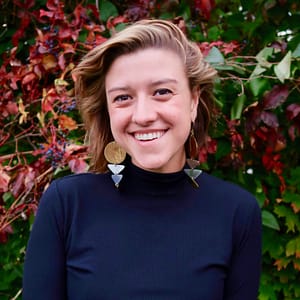The original version of this article was published on May 26, 2019. It remains one of our favorite pieces, and so we’ve brought it back for you to enjoy anew!
Americans are reaching the age of 65 at a rate of 11,000 people per day. And with life expectancies reaching almost 80 years old, we now have a whole generation of untapped potential! 1
For over a decade now, residents of a nursing home in New York have shared their lives–and their building–with high schoolers in a creative approach to exploring the best these generations have to offer one another.
At the Hebrew Home in Riverdale, New York, senior residents have been working with the students of the HOPE Program in ways that have enriched the lives of over 400 students and countless residents to date.
This visionary program has the highest graduation and attendance rate of any local alternative high school program. And as Hebrew Home resident Zelda Fassler put it,
“It’s what keeps my mind fresh, its what keeps me feeling young. People say you move into a nursing home and that’s it. But the HOPE class gives my life here meaning.”

Bringing HOPE to Hebrew Home
The HOPE program began in the 1992 as Hebrew Home CEO Dan Reingold saw a two-fold problem in his community. Firstly, the need to enhance the quality of life for the residents of the home. And secondly, to give young people with learning disabilities a place to learn in a nurturing environment. 2
Now, the program focuses on providing opportunities for education and vocational training to students with learning disabilities and autism.
Students involved in HOPE split their time between academics and working with the residents. This gives them the opportunity to learn alongside those in the Hebrew Home and to train for jobs in healthcare after high school!
This nurturing environment creates a space for connection between two communities that are very often isolated in society.
In an interview with the Seattle Times, former HOPE student and then 12 year Hebrew Home employee, Channel Reid, beautifully said of the residents she has befriended over the years,
“They believe in you, they give you this love,” she said. “Some of them are just so sweet it’s hard to not be attached to them.” 3
Seeing these beautiful relationships in action is a remarkable insight into the impact HOPE is having on the lives it touches. One of our favorite YouTube channels, Great Big Story, sat down with some of the residents and students to take a closer look!
To see more incredibly uplifting stories on every corner of life around the world, go check out the Great Big Story YouTube channel!
The power of a caring adult…
“Every child needs at least one adult who is irrationally crazy about him or her.”
—Uri Bronfenbrenner, Child Psycologist, Founder Head Start
Part of what make the HOPE Program so successful is that it combines solves two problems with one solution–young people in need of community, purpose, and vocational training, and seniors in need of social interaction, purpose, and to use a lifetime of experience. These same issues are common to so may youth and seniors across the world, and thankfully we are starting to see more organizations focused on bringing these two groups together.
The Stanford Center for Longevity partnered with Encore.org–now, CoGenerate.org–and the David and Lucile Packard Foundation in June of 2014 for the “Pass it On” conference to gather thought leaders finding a way to enrich the lives of older adults and youth through finding ways to bring them together. The report from the conference conference is an engaging and uplifting look at what’s possible if we are able to bring together the population of people entering retirement and youth that need their mentorship and support.
One of my favorite lines from the report reads:
“Meaningful interaction across the generations reaps clear benefits for young people, comparably important feelings of purpose for older adults, and enrichment that extends to the broader community. All of society reaps the vitality of a new generation of community-oriented citizens, mentored by the generation that will leave the stage ahead of them.” 5
If you are in a position to start this kind of mentoring program in your community, I highly suggest you checkout the full report that can help you get started. You can read the report by clicking here. You can also look for existing local programs using resources like AmeriCorps, or reaching out to your local schools and guidance counselors.
We have a tremendous opportunity to change the future of aging and the way young people grow up. There is no other time in history when so many generations have the potential to be deeply connected. What we make of this opportunity can shift the lives of people for generations to come!
Stay beautiful & keep laughing!
-Liesl

Don’t miss out on a single article!
Enjoy unlimited access to over 500 articles & podcast that give you a positive perspective on the state of the world and show you practical ways you can help.
Notes:
- Stanford Center on Longevity. “Hidden In Plain Sight: How Intergenerational Relationships Can Transform Our Future.” Stanford Center on Longevity, Longevity.stanford.edu, Sept. 2016, longevity3.stanford.edu/hidden-in-plain-sight-how-intergenerational-relationships-can-transform-our-future/. Accessed 8 May 2019. ↩
- “RiverWalk: Bronx Independent Living Facility — RiverSpring Health.” RiverSpring Living Nursing Home, Rehabilitation, and Managed Care, 12 Jan. 2021, www.riverspringliving.org/hope-program/. Accessed 3 Nov. 2022. ↩
- Sedensky, Matt. “A Nursing Home’s High School Teaches Lessons on Life.” The Seattle Times, The Seattle Times Company, 15 Oct. 2017, www.seattletimes.com/nation-world/a-nursing-homes-high-school-teaches-lessons-on-life/. Accessed 8 May 2019. ↩
- Great Big Story. “Why This High School Is In a Nursing Home.” YouTube, Great Big Story, 4 Apr. 2019, www.youtube.com/watch?v=IE71aiDK1-E. Accessed 8 May 2019. ↩
- Stanford Center on Longevity. “Hidden In Plain Sight: How Intergenerational Relationships Can Transform Our Future.” Stanford Center on Longevity, Longevity.stanford.edu, Sept. 2016, longevity3.stanford.edu/hidden-in-plain-sight-how-intergenerational-relationships-can-transform-our-future/. Accessed 8 May 2019. ↩








